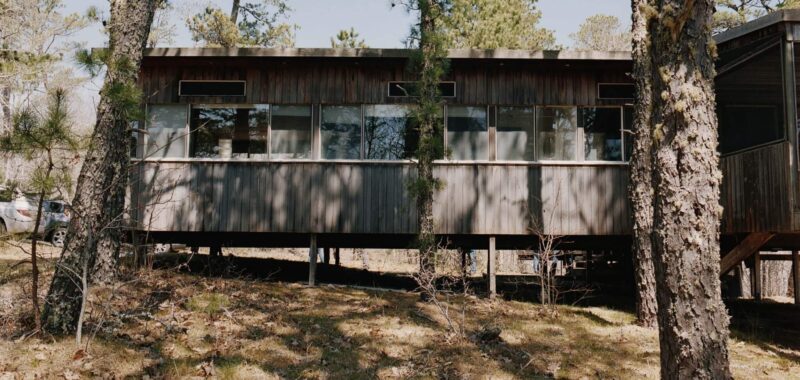Marcel Breuer was many things: a Hungarian citizen, a Bauhaus wunderkind, a Jewish refugee, designer of the Wassily chair. But since the prolific designer’s passing in 1981, there has been no foundation created, no trust endowed, and no museum erected in his name. Several notable Breuer homes have either been renovated without much respect or outright demolished.

This dearth of legacy insurance shocked the architectural world when the Cape Cod Modern House Trust (CCMHT) came out with a plea in 2023: Breuer’s experimental midcentury home in Wellfleet would be demolished in one year unless the Trust could raise $2 million in restoration funds.

The Breuer Restoration Project
Breuer fled the Nazis and arrived in the United States in 1937, where he began teaching at the Harvard GSD. Every year from 1941 till his death, Breuer summered with an extended group including other war refugees and expats like Walter Gropius, Constantino Nivola, and Eero Saarinen in what became the prototypical Long House in Wellfleet. The home evokes what we now call Cape Cod Modern—designed with cedar shingles turning grayer as they batter the New England weather, but with distinctively modern flat roofs and pilotis.

The style—and aesthetic, even, branching into the realm of lifestyle mimicry—has seized popular culture. But the feeling of being at the mercy of the wind and waves is also at the heart of Peter McMahon’s work. The director of CCMHT and author of Cape Cod Modern: Midcentury Architecture and Community on the Outer Cape is the central figure working to save the endangered house by giving it new life, as he has done with several other significant modern homes on “the Park,” or the National Seashore. Each was taken over by the National Park Service following the 1961 legislation banning development. While there were first plans for the National Park Service to demolish all structures built after 1959, it never quite got around to it. Instead, they were battered by the sea for decades and abandoned.
CCMHT maintains homes like the Kohlberg and Hatch Houses, leased from the National Park Service, through revenue from rentals and artist residencies. But Breuer’s house presented new challenges: This is the first property CCMHT would own, presenting a huge capital investment; new levels of international attention; and an existing tenant, Breuer’s son Tom.

The Long House had not been abandoned in the same way as others on the Park. Tom continued to summer there until friends and neighbors began to warn him of its sorry state, urging him to sell the property.
I witnessed the porch sagging under the weight of Breuer’s CMU tables one weekend in April, when I was invited to the site by McMahon along with experts in modern heritage from MoMA, Harvard, and other institutions for a working retreat. We debated how to preserve and renovate the property rather than sell it on the market, which would likely result in the home being demolished. Tom and Peter agreed on $2 million as a workable sum, which means if CCMHT can come up with the money, the home stands to be preserved. Currently CCMHT has more than half of the asking price and is working to fundraise the remaining amount.


What’s Significant?
CCMHT has already embarked on several structural renovations, but the softer updates were discussed that weekend in April. Tracy Neumann, a historian and editor at Historic New England, weighed in on the benefits of restoring for public use. “One of the things that I really admire about Peter’s vision for the Breuer House is that he wants to use it the way Breuer did, as a site for creative and scholarly work,” she said. “I love that the house will be lived in and worked in and enjoyed as a summer residence and studio just as it was originally designed to be.”
Ken Turino, a historian who focuses on historic site activations, commented on the archival works found in the house and their future. “Sure, we all agreed that the Klees and Calders must be taken out to avoid further degradation,” he began, “but what about the silverware, the coffee service? Those you can still buy today; they’re robust. Why not let people use them?”

Other questions concerned Breuer’s furniture. Like architecture, furniture is activated when used by the body. It’s bulky and requires maintenance. Breuer’s house is littered with Wassily and Cesca prototypes, midcentury Knoll original casts, and even experiments like cast iron candlesticks that made their way into St. John’s Abbey Church in Minnesota. These are perhaps what made McMahon suggest an on-site archive—a solution that aligns with his vision to keep Breuer’s heritage locally accessible.

Define “Value”
Preservationists seek to find a project’s “period of significance.” Historians need to decide which moment best represents the space, its inhabitants, and contemporary goals—though continuous change makes this a subjective call.
While the rare books and famous art have been archived away, the beautifully frustrating thing about architecture is that you cannot file it away in a cabinet. We’re at a turning point where the built environment is being recognized as just too resource intensive to see as disposable. Though Breuer’s Long House is one of the lighter kinds, stewarding the legacy of a simple way of American living—defined by a generation of immigrants—is worth any designer’s while.

Photographs by Meghan Marin, a Brooklyn-based photographer whose work focuses on portraiture and narrative. She was raised in upstate New York and draws heavily from her upbringing in the quiet of the country.

